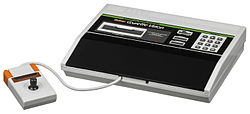Top Qs
Timeline
Chat
Perspective
Super Cassette Vision
Home video game console by Epoch Co. From Wikipedia, the free encyclopedia
Remove ads
The Super Cassette Vision (Japanese: スーパーカセットビジョン, Hepburn: Sūpā Kasetto Bijon) is a home video game console made by Epoch Co. and released in Japan on July 17, 1984, and in Europe, specifically France, later in 1984. A successor to the Cassette Vision, it competed with Nintendo's Family Computer and Sega's SG-1000 line in Japan.
This article needs additional citations for verification. (October 2025) |
Remove ads
History
Epoch's original Cassette Vision was introduced in Japan by Epoch in 1981, which had steady sales and took over 70% of the Japanese home console market at the time, with around 400,000 units sold.[2] However, the introduction of next-generation systems from Nintendo, Casio and Sega quickly pushed back the original Cassette Vision, leading Epoch to quickly develop a successor.

The Super Cassette Vision was released in 1984 with a price of ¥14,800,[3] featuring an 8-bit processor and better performance more in line with its competitors. It was later released in France by ITMC under the Yeno brand.[4] At least sixteen games were brought over from Japan for a European release.[5]
A version of the system targeting the young female market was released in 1985 as the Super Lady Cassette Vision (Japanese: スーパー カセットビジョン レディースセット) with a price of ¥19,300.[6] This console came packed in a pink carrying case, alongside the game Milky Princess.[7] The system did not take off, and was unable to match the massive popularity of the Nintendo Famicom, leading Epoch to drop out of the console market by 1987.
Remove ads
Technical specifications

The Super Cassette Vision had the following hardware specifications:[8]
- CPU: 8-bit NEC μPD7801G microcontroller @ 4 MHz
- RAM: 128 bytes (internal to CPU)
- ROM: 4 KB (internal to CPU)
- Video processor: EPOCH TV-1 VDC @ 14 MHz
- VRAM: 4 KB (2 × μPD4016C-2) + 2 KB (EPOCH TV-1 internal)
- Colors: 16
- Sprites: 20 per line
- Display: 309 × 246
- Sound processor: μPD1771C @ 6 MHz
- Sound: produced by NEC μPD1771C running a permanently burnt-in program with three modes - monophonic preset wave mode, polyphonic (4-channel) square wave and noise mode and ADPCM codec mode
- Controllers: 2 × hard-wired joysticks
Remove ads
Games
- 1. Astro Wars - Invaders from Space
- 2. Astro Wars II - Battle in Galaxy
- 3. Super Golf
- 4. Super Mahjong
- 5. Super Base Ball
- Giants Hara Tatsunori no Super Base Ball
- 6. Punch Boy
- 7. Elevator Fight
- 8. Lupin III
- 9. Nebula
- 10. Wheelie Racer
- 11. Boulder Dash
- 12. Miner 2049er
- 13. Super Soccer
- 14. Comic Circus
- 15. Milky Princess
- 16. Pop and Chips
- 17. Nekketsu Kung-Fu Road
- 18. Star Speeder
- 19 TonTon Ball
- 20. Super Sansu-Puter
- 21. Shogi Nyuumon
- 22. Doraemon
- 23. BASIC Nyuumon (included four basic games)
- 24. Dragon Slayer
- 25. Rantou Pro-Wrestling
- 26. WaiWai(Y2) Monster Land
- 27. Dragon Ball: The Great Unexplored Dragon Region
- 28. Mappy
- 29. Sky Kid
- 30. Pole Position II
Unreleased games
- Black Hole
- Super Derby
- Super Rugby
References
Wikiwand - on
Seamless Wikipedia browsing. On steroids.
Remove ads

